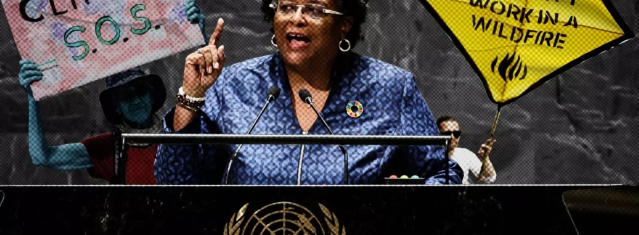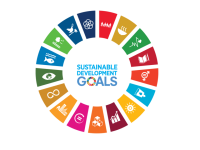News
AI, SMALL FIXES, AND THE WORLD BEYOND BIG AID:
TAKEAWAYS FROM THE UNGA SIDELINES

Prime Minister Mia Mottley of Barbados. UNGA (Source: Brendan McDermid and Eduardo Munoz/Reuters)
ARAC International StratCom -
This story was originally published by The New Humanitarian.
By Irwin Loy
The world is inching closer to “a great fracture”, UN Secretary-General António Guterres warned as global leaders converged in New York.
So did days of high-level summits and sideline chatter at the UN General Assembly pull us back from the brink?
The agenda was ambitious: kickstart systemic reform, accelerate climate action and pandemic prevention, and reverse poverty backslides.
By the time the general debate wound down for its last day on 26 September, world leaders had nudged forward on some counts, but spun their wheels on many others.
Overhauling the unequal global financial system has become a top-of-mind issue, but the smaller, climate-exposed nations pushing for reform continue to be frustrated with the slow pace of progress. Few hard promises emerged from either the summit meant to stir climate action or from the separate one on preventing pandemics.
And that’s not to mention the lack of headway on addressing either the humanitarian crisis in Sudan or Russia’s invasion of Ukraine – despite a high-level summit on the former and fiery speeches on the latter.
By Irwin Loy
The world is inching closer to “a great fracture”, UN Secretary-General António Guterres warned as global leaders converged in New York.
So did days of high-level summits and sideline chatter at the UN General Assembly pull us back from the brink?
The agenda was ambitious: kickstart systemic reform, accelerate climate action and pandemic prevention, and reverse poverty backslides.
By the time the general debate wound down for its last day on 26 September, world leaders had nudged forward on some counts, but spun their wheels on many others.
Overhauling the unequal global financial system has become a top-of-mind issue, but the smaller, climate-exposed nations pushing for reform continue to be frustrated with the slow pace of progress. Few hard promises emerged from either the summit meant to stir climate action or from the separate one on preventing pandemics.
And that’s not to mention the lack of headway on addressing either the humanitarian crisis in Sudan or Russia’s invasion of Ukraine – despite a high-level summit on the former and fiery speeches on the latter.
Here are a few notes and takeaways from the margins of this year’s UNGA high-level meetings:
It’s splashier on the sidelines:
The General Assembly spotlight may start at UN headquarters in midtown Manhattan, where nearby streets are annexed behind police barricades for a week. But pictures of motorcades and staged handshakes (“11:15 a.m. Photo Opportunity: The Secretary-General with H.E. Mr. Xavier Bettel, Prime Minister, GRAND DUCHY OF LUXEMBOURG”) can hold attention for only so long.
Meanwhile, in conference venues, studios, and repurposed offices across Manhattan, sideline events – some only tenuously tied to UNGA – are polished to a stage-managed sheen.
The Clinton Foundation turned its marquee Clinton Global Initiative into a two-day affair of panels and pledges peppered with TED-lite talks, micro-doses of inspiration, celebrity cameos, and yes, Clintons.
It’s splashier on the sidelines:
The General Assembly spotlight may start at UN headquarters in midtown Manhattan, where nearby streets are annexed behind police barricades for a week. But pictures of motorcades and staged handshakes (“11:15 a.m. Photo Opportunity: The Secretary-General with H.E. Mr. Xavier Bettel, Prime Minister, GRAND DUCHY OF LUXEMBOURG”) can hold attention for only so long.
Meanwhile, in conference venues, studios, and repurposed offices across Manhattan, sideline events – some only tenuously tied to UNGA – are polished to a stage-managed sheen.
The Clinton Foundation turned its marquee Clinton Global Initiative into a two-day affair of panels and pledges peppered with TED-lite talks, micro-doses of inspiration, celebrity cameos, and yes, Clintons.
Climate Week, meanwhile, run by a global network of businesses, is nominally pegged to UNGA but has become its own ecosystem of confabs, policy chats, and protests. Like many events staged alongside UNGA, attendees may have come for the mission (tagline: “Driving climate action. Fast.”), but they stuck around for the networking breaks and cocktail receptions.
One filmed event urged attendees not to be late for curtain time: “The show,” organisers warned, “will start promptly.” Another had black-clad bouncers gatekeeping a daytime affair. Microsoft played host to a tech-y 34th-floor reception that featured UN-blue wristbands and a jazz combo.
The elephant in the room:
Artificial intelligence had only minor billing on the official agenda but was a looming presence on the sidelines. Blame it on months of hype, hope, and fear triggered by the rise of ChatGPT.
One filmed event urged attendees not to be late for curtain time: “The show,” organisers warned, “will start promptly.” Another had black-clad bouncers gatekeeping a daytime affair. Microsoft played host to a tech-y 34th-floor reception that featured UN-blue wristbands and a jazz combo.
The elephant in the room:
Artificial intelligence had only minor billing on the official agenda but was a looming presence on the sidelines. Blame it on months of hype, hope, and fear triggered by the rise of ChatGPT.
To read the entire article by TNH Policy Editor, Irwin Loy, click on the link below.
ARAC International
SDG Advocate and Ambassador for Positive Peace
ARAC International
SDG Advocate and Ambassador for Positive Peace
more information: https://www.arac-international.org/2023/09/tnh-ai-small-fixes-and-world-beyond-big.html
Liability for this article lies with the author, who also holds the copyright. Editorial content from USPA may be quoted on other websites as long as the quote comprises no more than 5% of the entire text, is marked as such and the source is named (via hyperlink).






